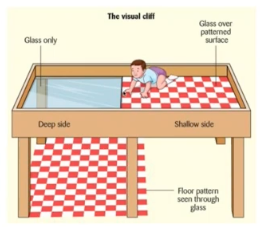20C (Gibson & Walk: depth perception, 1987)
1/21
There's no tags or description
Looks like no tags are added yet.
Name | Mastery | Learn | Test | Matching | Spaced |
|---|
No study sessions yet.
22 Terms
Background- sensory processing
infants are prone to falls
as they grow- avoidance of accidents
able to stand
avoid edges and objects
is this learning innate or a result of experience?
what did Gibson and Walk want to examine specifically
depth perception
how do infants develop depth perception
at what stage of development can an animal respond to depth and distance
does onset of these responses vary with animals or different species
the visual cliff
to investigate these question → created the visual cliff apparatus
on a foot long plank of wood
most commonly used for space perception
allows for control of auditory and tactual stimuli
protects participants (safe)- high in ecological validity but also safe

Experiment 1- participants
participants :
36 infants
6 months to 14 months
procedure
each child was placed on the centre board
mother calls them from the cliff side
mother calls infant to the shallow side
DV: does the child crawl?
findings
27/30 infants crawled to the shallow side
Only 3 crept onto the glass on the cliff side
Many infants crawled away from mother when she called to them on cliff side
Infants cried when mother stood on cliff side
Clear evidence of their dependence on vision
conclusion
Conclusion= most human infants can discriminate depth as soon as they can crawl
Sense of security depends on visual cues
Infants would often peer down through the glass on the deep side and back away
Others would pat the glass with their hands and still refuse to cross
Perception of depth matured more rapidly than locomotor abilities
However: does not prove that infants perception and avoidance of the cliff are innate
experimental replications
to test if it in innate:
visual cliff tested on:
chicks, turtles, rats, lambs, pigs, kittens and dogs
animals were placed on the centre
tested the direction they moved
goats and lambs placed on a surface that could be lowered ton create a visual cliff
further replications
adjustment of the depth of the deep side on visual cliff
fixed patterned material to a sheet of plywood
moved it up
lower it moved → deeper it appeared
findings
optical floor dropped → animal freezes in a defensive posture
conclusion= sense of security continued to depend on visual cues fro perception of depth
exception → rats depended on smell and tactual cues from whiskers
rats showed little preference to the shallow side
conclusions
Conclusions- Depth perception is dependent on visual cues
These develop early in life (chicks:24hrs)
Evolutionarily-wired
Rats may be different because nocturnal- depend on other sensory information
further replications
Bias in testing?
Gibson and Walk (1960) tested out different patterns
Different animals
Different depths
For all= concluded that depth perception is evolutionarily reared and independent of learning
→ may have been an interaction to the mothers emotional response and environment
extension
Perception of Affordances
1908s- Gibson reconceptualised her studies
The idea of ‘affordances’= fit between an animal’s physical capabilities and the features of the environment allow a particular action to be performed (Gibson, 1988)- own size relative to the drop
reconceptualisation led to a series of further studies
differences between crawling and walking
within the perception of affordances studies:
Gibson → focussed on crawling vs walking and rigidity of surface
Differences in stability of posture affect affordances of locomotion
Rigidity of ground surface varied (waterbed etc)
findings:
Crawling infants crossed a squishy waterbed more often than walking infants
Both groups went over rigid plywood
support for the idea of fit between physical capabilities and environment (perception of affordances)
Debate and controversy- criticisms
depth perception may be learnt due to interaction with their environment as they grow (crawling etc)
small samples
range of ages (may have learnt depth perception
but supported with animal studies
further ciriticims
did not examine the underlying reasons fro moving away from the visual cliff (parent interaction or depth perception?
glass on deep side= conflicting tactile information
conducted ina lab → low ecological validity
Impact and legacy
social referencing
Gibson & Walk (1987)
Noticed that human infants (only) seeked social information from mothers (e.g., held out their arms towards them, pointed to them, looked at them)
however: Gibson and Walk did not use visual cliff much in understanding infants’ use of social information in guiding action
Future studies-
use visual cliff as most famous paradigm for studying social referencing (Baldwin & Moses, 1996)
the future studies
examining maternal emotional signalling
Sorce, Emde, Campos & Klinnert (1985)
Examined the role of expressions of emotion on infants’ visual cliff responses
Participants:
Infants of 9-12 months
procedure
happy vs fear
used visual cliff with adjustment of depth
infants placed on shallow side of cliff, mother on deep side of cliff
mother placed toy on deep side and instructed to smile or fear face (no words, sounds or gestures)
maternal facial expressions scored independently by naïve raters
findings
mothers happy or fear signalling influenced infants’ behaviour
fearful expression → NONE of the infants went on the deep side (11 retreated)
happy face- 14/19 infants crossed on the deep side (3/19 retreated)
more studies on this social referencing
replications manipulated:
sadness
intermediate number crossed to deep side
absence of depth
few infants reference mother
conclusion → facial expression regulate behaviour in contexts of uncertainty
is this 100% replicable
nope, some conflicting evidence
Bradshaw et al (1987)
failed to replicate findings of mothers facial expression
did find an effect for speaking to infants AND having happy facial expression